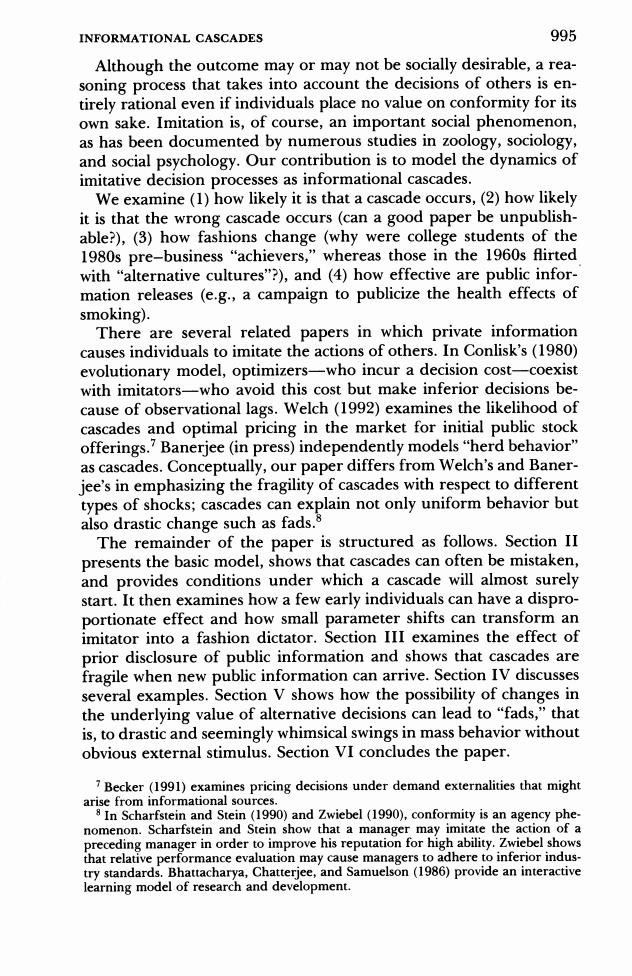正在加载图片...

INFORMATIONAL CASCADES 995 Although the outcome may or may not be socially desirable,a rea- soning process that takes into account the decisions of others is en- tirely rational even if individuals place no value on conformity for its own sake.Imitation is,of course,an important social phenomenon, as has been documented by numerous studies in zoology,sociology, and social psychology.Our contribution is to model the dynamics of imitative decision processes as informational cascades. We examine (1)how likely it is that a cascade occurs,(2)how likely it is that the wrong cascade occurs(can a good paper be unpublish- able?),(3)how fashions change (why were college students of the 1980s pre-business "achievers,"whereas those in the 1960s flirted with "alternative cultures"?),and (4)how effective are public infor- mation releases (e.g.,a campaign to publicize the health effects of smoking). There are several related papers in which private information causes individuals to imitate the actions of others.In Conlisk's(1980) evolutionary model,optimizers-who incur a decision cost-coexist with imitators-who avoid this cost but make inferior decisions be- cause of observational lags.Welch(1992)examines the likelihood of cascades and optimal pricing in the market for initial public stock offerings.'Banerjee(in press)independently models"herd behavior" as cascades.Conceptually,our paper differs from Welch's and Baner- jee's in emphasizing the fragility of cascades with respect to different types of shocks;cascades can explain not only uniform behavior but also drastic change such as fads.8 The remainder of the paper is structured as follows.Section II presents the basic model,shows that cascades can often be mistaken, and provides conditions under which a cascade will almost surely start.It then examines how a few early individuals can have a dispro- portionate effect and how small parameter shifts can transform an imitator into a fashion dictator.Section III examines the effect of prior disclosure of public information and shows that cascades are fragile when new public information can arrive.Section IV discusses several examples.Section V shows how the possibility of changes in the underlying value of alternative decisions can lead to"fads,"that is,to drastic and seemingly whimsical swings in mass behavior without obvious external stimulus.Section VI concludes the paper. 7 Becker(1991)examines pricing decisions under demand externalities that might arise from informational sources. 8 In Scharfstein and Stein (1990)and Zwiebel(1990),conformity is an agency phe- nomenon.Scharfstein and Stein show that a manager may imitate the action of a preceding manager in order to improve his reputation for high ability.Zwiebel shows that relative performance evaluation may cause managers to adhere to inferior indus- try standards.Bhattacharya,Chatterjee,and Samuelson(1986)provide an interactive learning model of research and development